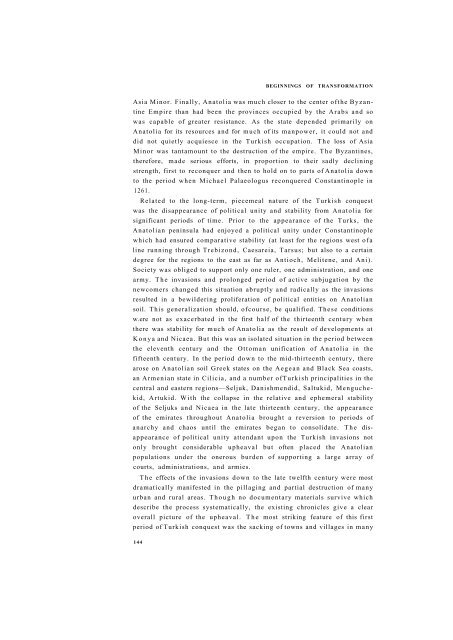III. The Beginnings of Transformation
III. The Beginnings of Transformation
III. The Beginnings of Transformation
Create successful ePaper yourself
Turn your PDF publications into a flip-book with our unique Google optimized e-Paper software.
BEGINNINGS OF TRANSFORMATION<br />
Asia Minor. Finally, Anatolia was much closer to the center <strong>of</strong>the Byzan<br />
tine Empire than had been the provinces occupied by the Arabs and so<br />
was capable <strong>of</strong> greater resistance. As the state depended primarily on<br />
Anatolia for its resources and for much <strong>of</strong> its manpower, it could not and<br />
did not quietly acquiesce in the Turkish occupation. <strong>The</strong> loss <strong>of</strong> Asia<br />
Minor was tantamount to the destruction <strong>of</strong> the empire. <strong>The</strong> Byzantines,<br />
therefore, made serious efforts, in proportion to their sadly declining<br />
strength, first to reconquer and then to hold on to parts <strong>of</strong> Anatolia down<br />
to the period when Michael Palaeologus reconquered Constantinople in<br />
1261.<br />
Related to the long-term, piecemeal nature <strong>of</strong> the Turkish conquest<br />
was the disappearance <strong>of</strong> political unity and stability from Anatolia for<br />
significant periods <strong>of</strong> time. Prior to the appearance <strong>of</strong> the Turks, the<br />
Anatolian peninsula had enjoyed a political unity under Constantinople<br />
which had ensured comparative stability (at least for the regions west <strong>of</strong>a<br />
line running through Trebizond, Caesareia, Tarsus; but also to a certain<br />
degree for the regions to the east as far as Antioch, Melitene, and Ani).<br />
Society was obliged to support only one ruler, one administration, and one<br />
army. <strong>The</strong> invasions and prolonged period <strong>of</strong> active subjugation by the<br />
newcomers changed this situation abruptly and radically as the invasions<br />
resulted in a bewildering proliferation <strong>of</strong> political entities on Anatolian<br />
soil. This generalization should, <strong>of</strong>course, be qualified. <strong>The</strong>se conditions<br />
w.ere not as exacerbated in the first half <strong>of</strong> the thirteenth century when<br />
there was stability for much <strong>of</strong> Anatolia as the result <strong>of</strong> developments at<br />
Konya and Nicaea. But this was an isolated situation in the period between<br />
the eleventh century and the Ottoman unification <strong>of</strong> Anatolia in the<br />
fifteenth century. In the period down to the mid-thirteenth century, there<br />
arose on Anatolian soil Greek states on the Aegean and Black Sea coasts,<br />
an Armenian state in Cilicia, and a number <strong>of</strong>Turkish principalities in the<br />
central and eastern regions—Seljuk, Danishmendid, Saltukid, Menguche-<br />
kid, Artukid. With the collapse in the relative and ephemeral stability<br />
<strong>of</strong> the Seljuks and Nicaea in the late thirteenth century, the appearance<br />
<strong>of</strong> the emirates throughout Anatolia brought a reversion to periods <strong>of</strong><br />
anarchy and chaos until the emirates began to consolidate. <strong>The</strong> dis<br />
appearance <strong>of</strong> political unity attendant upon the Turkish invasions not<br />
only brought considerable upheaval but <strong>of</strong>ten placed the Anatolian<br />
populations under the onerous burden <strong>of</strong> supporting a large array <strong>of</strong><br />
courts, administrations, and armies.<br />
<strong>The</strong> effects <strong>of</strong> the invasions down to the late twelfth century were most<br />
dramatically manifested in the pillaging and partial destruction <strong>of</strong> many<br />
urban and rural areas. Though no documentary materials survive which<br />
describe the process systematically, the existing chronicles give a clear<br />
overall picture <strong>of</strong> the upheaval. <strong>The</strong> most striking feature <strong>of</strong> this first<br />
period <strong>of</strong> Turkish conquest was the sacking <strong>of</strong> towns and villages in many<br />
144






